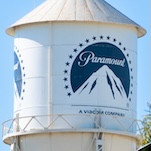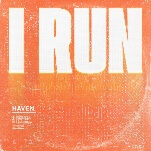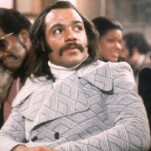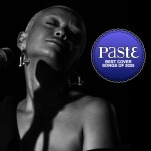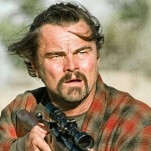RP: I’ve produced, or had my hand in producing probably about 90 soundtrack albums over the years. I did produce a record. I’m bad with years, but it must have been somewhere between five and 10 years ago, a compilation called Guilt By Association where I had basically all these bands that I loved cover their guilty-pleasure pop songs. It’s worth seeking out. There’s a great version of Will Oldham singing Mariah Carey’s “Can’t Take That Away.”
AVC: Was putting together a record outside the scope of a film something you’d always wanted to do?
RP: I think maybe what prompted it is that Todd Haynes’ I’m Not There is kind of a Bob Dylan tribute album. We did almost 40 songs. What’s nice about it—or what’s fun in doing these records—is that I can basically decide what songs to do, and who to do them, really. I don’t have to squeeze the songs into a 90-second sequence or anything like that. There’s a little bit of creative freedom in doing this. Yet, also, I borrow from all of my filmmaking skill set in terms of what I try to do with these records, through the combination and the sequencing, to kind of tell the story of the artist without a firmer narrative except the collision of the songs one against the other.
AVC: Antony doing “Landslide” is one thing, but how do you go from thinking, “Okay, someone should do ‘Peggy Sue’” to knowing who should do it?
RP: These artists are all of a certain caliber that you certainly can’t play the part of dictator, because it’s not like I shower them with gold coins. There’s a back-and-forth that goes with it, and I think you have to sort of share the making with the artist. Sometimes you have an artist that you feel like you want to work with and they’re like, “Okay, I know what I want.”
For instance, it’s funny that you say “Peggy Sue,” because when we went to Lou Reed, we had gotten word that he was a big Buddy Holly fan, and we said, “Okay, well, what song would he want to do?” “Well, ‘Peggy Sue.’” And then he said, “I can’t believe nobody else has done ‘Peggy Sue.’” Then we did an interview with Lou Reed and one of the questions was, of course, “Do you remember the first time you heard Buddy Holly?” and he said, “Yeah, ‘Peggy Sue.’”
There’s a dialogue that happens with the artist that sort of leads you one way or another as well. Whereas Antony’s cover came from a bit of a preconception and he thankfully responded to the idea, sometimes it’s just like, “You know what, that’s an interesting idea, but I always wanted to do this one.” Sometimes they come right at you with what they want to do, or they say, “Send me some songs, and let’s talk about it.” It works in those different ways.
With this record, we knew that we certainly needed to cover certain bases. You reach out to artists who you think have a certain predilection, say to the Peter Green material. Or with MGMT, who I’d been trying forever to get them to do things with me, and this was really the first time they agreed—when I put it out there, my suspicion was that they would do a Bob Welch track. That’s sort of the joy of the collaboration, where even when you work on a movie, the fact that it’s a film is kind of the sum parts of a lot of people’s energy coming together. As much as there’s a director who is the leader and decider and visionary, everybody that puts their energy into it just makes it that much more powerful.
Calexico & Jim James, “Goin’ To Acapulco” (from 2007’s I’m Not There)
RP: “Goin’ To Acapulco” was a song that was in that situation. There was a scene in the movie that Todd had indicated that should be “Goin’ To Acapulco.” We knew it should be a brass band, and I had worked previously with Calexico, so I had this notion that Calexico would make the music, and we actually had a couple of other ideas that weren’t right, and sort of somehow landed on Jim James. Then Jim James actually comes back and says, “You know ‘Goin’ To Acapulco’ is my favorite Bob Dylan Song.” That’s how that came together.
Generally when you make these records, you want there to be variety, but you also want there to be some confluence. I think Calexico probably produced a half a dozen tracks on that record. That’s kind of the excitement of doing these things, because an artist gets to work together with people they hadn’t worked with before without having to do a whole record or having to commit beyond a single song. They get to try each other’s clothes on a little bit.
Benjamin Britten, “Noye’s Fludde/Noah’s Flood” (from 2012’s Moonrise Kingdom)
AVC: On Wes Anderson soundtracks, there’s often one artist that runs through the soundtrack, like Seu Jorge on The Life Aquatic and Cat Stevens on Rushmore. Is that something you do to create a mood?
RP: Wes will have an inspiration and then basically I go and I gather all of the related material. For instance, Moonrise Kingdom began with Benjamin Britten’s “Noye’s Fludde/Noah’s Flood.” Before there was even a script, Wes had talked to me and said there was this piece of music and he wanted to do something with it. So basically I go out and I collect all of Benjamin Britten. Then it’s sort of been our strategy, or our kind of enterprise to say, “Okay, let’s try to use as much of it as possible.” That’s how we build it.
It’s the same thing in terms of, say, The Darjeeling Limited, where we basically said, “Okay, let’s use film scores that were either in Satyajit Ray films or that he made for other films and other filmmakers.” Then it becomes my job to go out and get all that material, which actually involved going to Calcutta to pick some of this stuff up. Then you find things out—like, there’s this scene in The Darjeeling Limited where there’s a flashback where the brothers go and pick up their father’s car on their way to his funeral, and we wanted to have music in that scene and we thought, “Well maybe we should have a piece of classical music.” And in my research, Beethoven’s Seventh Symphony was Satyajit Ray’s favorite piece of Western music, so I was like, “Well, let’s use that.”
So hopefully you mind the connections and mind the logic and it leads you to the right place. In the seven movies that we’ve worked on together, we have faith in that process. It all comes together and holds together because Wes just has this filmmaking genius.
AVC: How often does that happen? Wes Anderson and Harmony Korine seem like they would have a very specific vision, but have you done other movies where the director just says, “We like rock ’n’ roll. Go crazy”?
RP: Yeah, I think there are films where there’s sometimes a little bit more preconception and sometimes there’s a little bit less. And sometimes you have to wait until the film tells you where you need to go or what it needs for musical sustenance.
Folk Implosion, “Natural One” (from 1995’s Kids)
AVC: When you were doing Kids, did you think, “This needs a lot of Folk Implosion?”
RP: [Laughs.] There was no Folk Implosion, really. That was sort of the greatest surprise. That was really Harmony. We had been listening to a lot of Lou Barlow and a lot of Sebadoh and Lou Barlow’s homemade cassettes. Folk Implosion was the vehicle that Lou, at that point, wanted to be how he made music. And the producer, Wally Gagel, was really critical in making that sound. Then it just sort of happened.
With “Natural One,” at a certain point we were like, “We should put some lyrics and voice on this piece of music.” In a way, that was one of the most surprising things in my whole career. Who would have ever thought that Folk Implosion and Kids would have a Top 40 single? That’s a song I think people will bring back. That song was so groovy.
Skrillex, various songs (from 2012’s Spring Breakers)
RP: The endurance of my career is really steeped in the fact that I have aligned myself with just really brilliant, bold, fearless filmmakers and they continue to make movies. Harmony is a person who just has an incredible sense of the cultural pulse and how to undermine it. Spring Breakers is out of control.
Phil Collins, “In The Air Tonight” (from 2009’s The Hangover)
AVC: Did Todd Phillips say, “It needs to be ‘In The Air Tonight’ in this scene” or was that you?
RP: It’s all born out of the directors. That was specifically Todd. This is the seventh movie I’ve worked on with Todd. Todd is just a comic genius. Again, there’s a large part of the music in the Hangovers where there’s an evolving musical element that I think serves the film, and Todd uses music very well. Some of the most comic moments were the on-camera moments, and those are scripted, and those are really a part of the basic fabric of the movie. We may have been presenting these things, but at those points, it’s just what he thinks is going to be the funniest that gets selected.
Boardwalk Empire (2010 to present)
AVC: How do you move from project to project? How big is your library?
RP: I would say it’s pretty voluminous. It’s a bit of a mess, my library. I think that sometimes there’s a misconception that I know every song that’s ever been made or recorded. But really with something like, say, Boardwalk Empire—which started out in 1920, and now the season will be in 1923—that’s a very early time in music. So that’s why I use my scholastic skills and really bear down and study and read books and research and ask people and find experts. I think in terms of the variety, that’s what keeps you fresh. I can go from Skrillex to Al Jolson in the course of an hour.
Gwyneth Paltrow, “Country Strong” (from 2010’s Country Strong)
RP: I love country music, which surprises people sometimes, so I’d always been looking to do something in country music. That was just a blast just to be able to go and spend time in Nashville and really come to understand things, to have a little bit of an inside look at how the Nashville music machine works, and really get to work in Nashville. The joy of Nashville really is the songwriting and how songwriting happens there. It’s just really special and unique and filled with talented people. In Nashville they have such a reverence for the country-music legacy that it ennobles the whole undertaking.
AVC: How much of your process is just capturing a scene?
RP: I think it’s capturing a spirit, really, especially when you’re doing period music, and especially period rock. Say with, like, I’m Not There, Dylan goes electric at Newport, and it’s a revolutionary moment, but you play the music for a contemporary audience and they’re like, “Well, that’s rock ’n’ roll. What’s so special about that?” So how do you both render the material faithfully and remain faithful to the novelty of it? How do you render the impression of novelty to an audience that is 40 years out? That’s a way where working with the likes of Lee Ranaldo from Sonic Youth worked, where on some of that material we say, “Okay, we’re going to electrify it in a way that may not be absolutely true to time, but is true to the spirit of the moment.”







